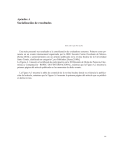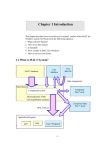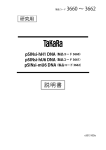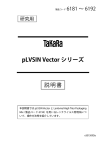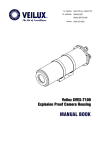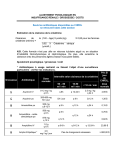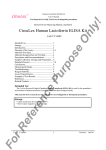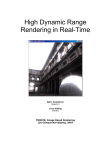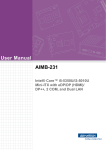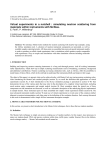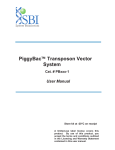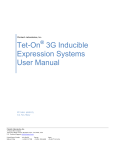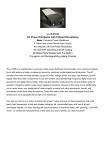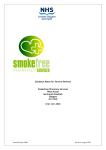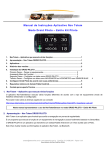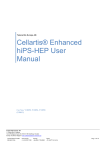Download RetroNectin® Recombinant Human Fibronectin Fragment
Transcript
Cat. # T100A/B For Research Use RetroNectin® Recombinant Human Fibronectin Fragment Product Manual v201303 RetroNectin® (Recombinant Human Fibronectin Fragment) Cat. #T100A/B v201303 Table of Contents I. Description........................................................................................................................3 II. Components.....................................................................................................................4 III. Storage................................................................................................................................4 IV. Materials Required but not Provided......................................................................4 V. Protocol...............................................................................................................................5 1. Preparation of RetroNectin Coated Plates.....................................................5 2. Gene Transduction..................................................................................................5 A. RetroNectin-bound Virus (RBV) Infection Method...............................6 B. Supernatant (SN) Infection Method...........................................................8 VI. References..........................................................................................................................9 VII. Related Products.............................................................................................................9 2 URL:http://www.takara-bio.com RetroNectin® (Recombinant Human Fibronectin Fragment) I. Cat. #T100A/B v201303 Description RetroNectin reagent is a recombinant human fibronectin fragment (rFN-CH-296) composed of three functional domains: the cell-binding domain (C-domain), heparin-binding domain (H-domain), and CS-1 sequence. The fragment enhances retroviral-mediated gene transduction by aiding the co-localization of target cells and virions. Specifically, virus particles bind RetroNectin reagent via interaction with the H-domain, and target cells bind mainly through the interaction of cell surface integrin receptor VLA-5 and VLA-4 with the fibronectin C-domain and CS-1 site, respectively. Through facilitating close proximity, RetroNectin reagent can enhance retroviral-mediated gene transfer to target cells expressing integrin receptors VLA-4 and/or VLA-5*1. There are two RetroNectin-mediated infection protocols: the supernatant (SN) infection method and the RetroNectin-bound virus (RBV) infection method 5), *2. With the SN infection method, cells are mixed with virus supernatant and loaded on a RetroNectin-coated plate. In the RBV method, the retrovirus is first bound to the RetroNectin coated plate, and cells are added after removing the retrovirus supernatant. Removal of the supernatant reduces inhibitory molecules (e.g., molecules secreted from the producer cells such as proteoglycans and/or viral envelope proteins) that can reduce the efficiency of viral-mediated gene transduction. *1 : RetroNectin can also enhance lentiviral-mediated gene transfer. *2 : Both methods can be used for efficient gene transduction. Although the RBV infection method is widely applicable, some modification might be required depending on the target cells, vectors, and/or target genes. TargetCell receptor VLA-5(α5β1) VLA-4(α4β1) CS-1 Cell-bindingdomain (C-Domain;RGDS) Heparin-binding domain(H-Domain) RGDS RetroNectin(CH-296) RGDS SH 1 Fibrin Collagen Heparin 9 10 Cell Fibronectin NH2 8 2 3 4 5 DNA 6 7 8 CS-1 12 13 14 Heparin CS-1 9 10 11 12 13 14 Cell Blue:bindingdomain SH SS COOH Heparin Cell Fibrin (IIICS) Figure 1. The hypothesized mechanism of RetroNectin-mediated transduction. The cell binds to the CS-1 site via VLA-4, and to the C-domain via VLA-5. The viral particle can bind to the H-domain of RetroNectin. These interactions increase the localized concentrations of cells and viral particles, an effect that is thought to enhance gene transduction. URL:http://www.takara-bio.com 3 RetroNectin® (Recombinant Human Fibronectin Fragment) Cat. #T100A/B v201303 II. Components RetroNectin (Cat. #T100A) RetroNectin (Cat. #T100B) 0.5 mg (0.5 ml) 2.5 mg (2.5 ml) Note: RetroNectin is provided as a sterile 1 mg/ml solution. III. Storage -20℃ Caution: Freezing and thawing can be repeated up to 10 times. Do not mix the solution vigorously. Do not vortex. IV. Materials Required but not Provided [Equipment] • Non-treated tissue culture plates or dishes • Electric pipetter • Pipetter • Sterile pipettes • Sterile tips with filters • Safety cabinet or clean workstation • Microscope • CO2 incubator • Microplate centrifuge [Reagents] • Sterile PBS ( - ) (Phosphate Buffered Saline) • HBSS/Hepes (Hank's Balanced Salt Solution supplemented with 2.5% (v/v) 1 M Hepes) • 2% BSA (BSA Fraction V)/PBS Solution 4 URL:http://www.takara-bio.com RetroNectin® (Recombinant Human Fibronectin Fragment) Cat. #T100A/B v201303 V. Protocol 1.Preparation of RetroNectin Coated Plates Coat a plate using 20 - 100 μg/ml RetroNectin with a volume corresponding to 4 - 20 μg/cm2 plate area. (1) Prior to coating, prepare a RetroNectin solution (20 - 100 μg/ml*1) by diluting with sterile PBS. *1 : Example of calculating amount of RetroNectin reagent : When 2.25 ml of RetroNectin solution at a concentration of 20 μg/ml is placed into a 35 mm diameter dish (9 cm2), the concentration used for coating is 5 μg/cm2. Note: To avoid loss of RetroNectin fragment, do not filter sterilize RetroNectin solution diluted with PBS. (2) Dispense an appropriate volume*2 of sterile RetroNectin solution into each plate and allow the plate to stand for 2 hours at room temperature or at 4℃ overnight. *2 : Dispense 0.5 ml into each well of a 24-well plate or 2 ml into each well of a 6-well plate. Note : Non-treated, cell culture-grade tissue culture plates or dishes should be used in this step. (3) Remove the RetroNectin solution and then block with an appropriate volume*3 of sterile 2% bovine serum albumin (BSA, Fraction V) in PBS. Allow the plate to stand at room temperature for 30 minutes. *3 : Use 0.5 ml for each well of a 24-well plate or 2 ml for each well of a 6-well plate. (4) Remove the BSA solution, and wash the plate once with an appropriate volume of HBSS/Hepes or PBS. After removing the wash solution, the plate is ready for use. The RetroNectin coated plate can be sealed with Parafilm and stored at 4℃ for up to one week. 2.Gene Transduction There are two methods of gene transduction using RetroNectin reagent: RetroNectin-bound virus (RBV) infection method (Section A) and supernatant (SN) infection method (Section B). In the RBV infection method, retroviral particles are first bound to the plate coated with RetroNectin reagent, and the target cells are added after removing the virus supernatant. In the SN infection method, the virus solution and target cells are mixed and then added to the RetroNectin coated plate. When virus solution is directly used for virus infection without purification, the gene transduction efficiency may be reduced because of contaminating molecules that inhibit infection. In such cases, the RBV infection method is recommended. With this method, inhibitory molecules can be removed by binding viruses to RetroNectin reagent and removing the supernatant. Note: Using a transient production system, such as the Retrovirus Packaging Kit Eco/ Ampho (Cat. #6160/6161)* and the pDON-AI-2 vector (Cat. #3654/3653), retroviral vectors can be prepared in one week. * : Not available in all geographic locations. Check for availablity in your region. URL:http://www.takara-bio.com 5 RetroNectin® (Recombinant Human Fibronectin Fragment) Cat. #T100A/B v201303 A. RetroNectin Bound Virus (RBV) Infection Method A-1. Preparation of virus bound plate without centrifugation 1. Add retrovirus supernatant at 125 - 250 μl/cm2 to a RetroNectin coated plate or dish. 2. Incubate for 4 to 6 hours at 32℃ or 37℃ in a 5% CO2 incubator to promote binding of the virus particles with RetroNectin reagent. 3. Discard the supernatant, but do not allow the plate to dry. Wash the plate with an appropriate volume of PBS or PBS containing 0.1 - 2% albumin (BSA or HSA). After washing, perform infection according to A-3. A-2. Preparation of virus binding plate by centrifugation If the virus titer is high enough, binding of viruses with RetroNectin reagent can be accomplished without centrifugation as described in A-1. However, if the titer is low, or if you require higher gene transduction efficiency, binding the virus by centrifugation is preferable. With this method the time required to bind the retrovirus is significantly less (2 hours versus 4 6 hours for the non-centrifugation method). A plate, such as a non-treated cell culture plate, that can tolerate centrifugation at 1,000 - 2,000X g for 2 hours at 32℃ is required for this method. In addition, please note there is a possibility of aerosol formation. 1. Add the retrovirus stock solution or diluted solution at 125 - 500 μl/cm2 to the RetroNectin coated plate. Note: The volume that can be added to the plate varies. For a 6-well plate, the upper limit is 3 ml (320 μl/cm2). In this method, some infection inhibitory molecules may not be removed by washing with PBS. For this reason the efficiency of gene transduction might be reduced. In such a case, it is recommended that the virus stock solution be used after dilution with growth medium. Optimization is required to determine the suitable dilution rate. 2. Place the plate in a centrifuge pre-warmed to 32℃ and centrifuge for 2 hours at 32℃ at 1,000 - 2,000X g to facilitate binding of virus particles with RetroNectin reagent. 3. Discard the supernatant, but do not allow the plate to dry. Wash the plate with an appropriate volume of PBS or PBS containing 0.1 - 2% albumin (BSA or HSA). Then perform virus infection according to A-3. 6 URL:http://www.takara-bio.com RetroNectin® (Recombinant Human Fibronectin Fragment) Cat. #T100A/B v201303 A-3. Virus Infection Prepare the target cells while the retrovirus particles are binding to the RetroNectin reagent coated plate. It is important that the target cells be in logarithmic growth phase and express integrin receptors VLA-4 and/or VLA5. When using hematopoietic stem cells, pre-stimulation with cytokine may be necessary. The cytokine type should be determined based on your specific research protocols. Examples are cited in references 3 and 5. 1. Collect the target cells and count the number of living cells. Then suspend the cells in the growth medium at a concentration of 0.2 - 1 x 105 cells/ml. 2. Remove the wash solution from the virus bound plates prepared by A-1 or A-2. Do not allow the plate to dry. Immediately add target cells at a density of 0.5 - 2.5 x 104 cells/cm2. Although the optimal cell density depends on cell size and growth rate, the initial cell density should allow the cells to be actively growing or nearly confluent when analyzed 2 - 3 days after transduction. When infecting more cells, you may increase the cell density, but the cells will need to be subcultured after gene transduction. Note: To promote contact between the target cells and viral particles, plates can be centrifuged after adding the cells. 3. Incubate in a 37℃, 5% CO2 incubator for 2 - 3 days. 4. Collect both non-adherent and adherent cells: (1) Transfer the supernatant to a centrifuge tube. (2) Recover remaining non-adherent cells by washing the plate with PBS. (3) Dissociate adherent cells from the plate with Cell Dissociation Buffer (Life Technologies), an enzyme free solution, or trypsin-EDTA following the manufacturer's instructions. Note: For many cell types, adherent cells may be collected by pipetting only. (4) Combine the cells obtained from steps (1)-(3) in the same tube, and centrifuge to recover the cells. (5) Wash the cells with HBSS/Hepes twice, collecting the cells by centrifugation. Suspend the cells in HBSS/Hepes* for further analysis. * : Any buffer or medium suitable for downstream application of the cells can be also used for resuspension. URL:http://www.takara-bio.com 7 RetroNectin® (Recombinant Human Fibronectin Fragment) Cat. #T100A/B v201303 B. Supernatant (SN) Infection Method When the virus stock solution is used, the RBV method described in A is recommended, but if a 4-fold dilution or more is used, either the RBV or SN method may be used as equivalent gene transduction efficiency will be obtained. The time required for virus infection is much shorter with the SN method than with the RBV method. 1. Suspend the target cells in virus solution that has been diluted with growth medium to prepare the cell suspension. 2. Add the cell suspension to the RetroNectin coated plate at a density of 0.5 - 2.5 x 104 cells/cm2. Although the optimal cell density depends on cell size and growth rate, the initial cell density should allow the cells to be actively growing or nearly confluent when gene expression is analyzed 2 - 3 days after transduction. When infecting more cells, you may increase the cell density, but the cells will need to be subcultured after gene transduction. Note: To promote contact between the target cells and virus vectors, the plate can be centrifuged after adding the cells. 3. Incubate in a 37℃, 5% CO2 incubator for 2 - 3 days. 4. Collect both non-adherent and adherent cells: (1) Transfer the supernatant to a centrifuge tube. (2) Recover remaining non-adherent cells by washing the plate with PBS. (3) Dissociate adherent cells from the plate with Cell Dissociation Buffer (Life Technologies), an enzyme free solution, or trypsin-EDTA following the manufacturer’ s instructions. Note: For many cell types, adherent cells may be collected by pipetting only. (4) Combine the cells obtained from steps (1)-(3) in the same tube, and centrifuge to recover the cells. (5) Wash the cells with HBSS/Hepes twice, collecting the cells by centrifugation. Suspend the cells in HBSS/Hepes* for further analysis. * : Any buffer or medium suitable for downstream application of the cells can be also used for resuspension. 8 URL:http://www.takara-bio.com RetroNectin® (Recombinant Human Fibronectin Fragment) Cat. #T100A/B v201303 VI. References 1) Kimizuka F, Taguchi Y, Ohdate Y, Kawase Y, Shimojo T, Hashino K, Kato I, Sekiguchi K, and Titani K. (1991) Production and characterization of functional domains of human fibronectin expressed in Escherichia coli. J. Biochem . 110:284-291. 2) Hanenberg H, Xiao XL, Dilloo D, Hashino K, Kato I, and Williams DA. (1996) Colocalization of retrovirus and target cells on specific fibronectin fragments increases genetic transduction of mammalian cells. Nat Med . 2:876-882. 3) Hanenberg H, Hashino K, Konishi H, Hock RA, Kato I, and Williams DA. (1997) Optimization of fibronectin-assisted retroviral gene transfer into human CD34+ hematopoietic cells. Hum . Gene Ther . 8:2193-2206. 4) Pollok KE, Hanenberg H, Noblitt TW, Schroeder WL, Kato I, Emanuel D, and Williams DA. (1998) High-efficiency gene transfer into normal and adenosine deaminasedeficient T lymphocytes is mediated by transduction on recombinant fibronectin fragments. J. Virol . 72:4882-4892. 5) Chono, H., Yoshioka, H., Ueno, M. and Kato, I. (2001) Removal of inhibitory substance with recombinant fibronectin-CH-296 plates enhances the retroviral transduction efficiency of CD34+CD38- bone marrow cells. J. Biochem . 130:331-334. VII. Related Products Retroviral vectors pDON-AI-2 Neo DNA pDON-AI-2 DNA (Cat. #3653) (Cat. #3654) Preparation of Recombinant Retroviral Particles Retrovirus Packaging Kit Ampho Retrovirus Packaging Kit Eco Retro-X™ System Retro-X™ Universal Packaging System (Cat. #6161)* (Cat. #6160)* (Clontech, Cat. #631508) (Clontech, Cat. #631530) Lentiviral Vectors and Vector Systems Lenti-X™ Expression System Lenti-X™ Expression System (EF1alpha Version) (Clontech, Cat. #632164) (Clontech, Cat. #631253) Preparation of Recombinant Lentiviral Particles Lenti-X™ 293T Cell Line Lenti-X™ HTX Packaging System Lenti-X™ HTX Ecotropic Packaging System (Clontech, Cat. #632180) (Clontech, Cat. #631247) (Clontech, Cat. #631251) Other RetroNectin® Pre-coated Dish RetroNectin® (GMP) Retrovirus Titer Set (for Real Time PCR) Retro-X™ qRT-PCR Titration Kit Lenti-X™ qRT-PCR Titration Kit (Cat. #T110A) (Cat. #T201)* (Cat. #6166)* (Clontech, Cat. #631453) (Clontech, Cat. #631235) * : Not available in all geographic locations. Check for availability in your region. URL:http://www.takara-bio.com 9 RetroNectin® (Recombinant Human Fibronectin Fragment) 10 Cat. #T100A/B v201303 URL:http://www.takara-bio.com RetroNectin® (Recombinant Human Fibronectin Fragment) Cat. #T100A/B v201303 NOTICE TO PURCHASER: LIMITED LICENSE [L9] RetroNectin® A method to increase the efficiency of retrovirus mediated gene transfer (covered by the claims of U.S. Patent No. 5,686,278, 6,033,907, 7,083,979, and 6,670,177 and their foreign counterpart patent claims)is licensed to TAKARA BIO INC. exclusively and worldwide. [M69] RetroNectin® Expansion Method This product is covered by the claims of Japanese Patent No. 4406566 and its foreign counterpart patent claims. URL:http://www.takara-bio.com 11 RetroNectin® (Recombinant Human Fibronectin Fragment) Cat. #T100A/B v201303 NOTE : This product is for research use only. It is not intended for use in therapeutic or diagnostic procedures for humans or animals. Also, do not use this product as food, cosmetic, or household item, etc. Takara products may not be resold or transferred, modified for resale or transfer, or used to manufacture commercial products without written approval from TAKARA BIO INC. If you require licenses for other use, please contact us by phone at +81 77 543 7247 or from our website at www.takara-bio.com. Your use of this product is also subject to compliance with any applicable licensing requirements described on the product web page. It is your responsibility to review, understand and adhere to any restrictions imposed by such statements. All trademarks are the property of their respective owners. Certain trademarks may not be registered in all jurisdictions. 12 URL:http://www.takara-bio.com













